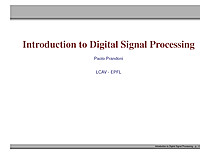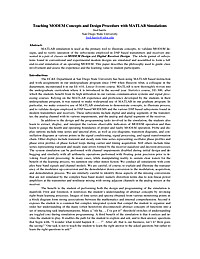
Teaching MODEM Concepts and Design Procedure with MATLAB Simulations
MATLAB simulation is used as the primary tool to illustrate concepts, to validate MODEM designs, and to vent' operation of the subsystems employed in DSP based transmitters and receivers presented in a pair of classes on MODEM Design and Digital Receiver Design. The whole gamut of subsystems found in conventional and experimental modem designs are simulated and assembled to form a full end-to-end simulation of an operating MODEM. This paper describes the philosophy used to guide class involvement and assess the experience and the learning value to student participants.
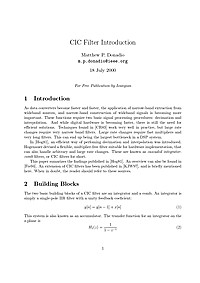
Cascaded Integrator-Comb (CIC) Filter Introduction
In the classic paper, "An Economical Class of Digital Filters for Decimation and Interpolation", Hogenauer introduced an important class of digital filters called "Cascaded Integrator-Comb", or "CIC" for short (also sometimes called "Hogenauer filters"). Here, Matthew Donadio provides a more gentle introduction to the subject of CIC filters, geared specifically to the needs of practicing DSP designers.
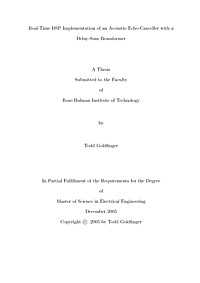
Real-Time DSP Implementation of an Acoustic-Echo-Canceller with a Delay-Sum Beamformer
Traditional telephony uses only a single receiver for speech acquisition. If the speaker is standing away from the telephone, the signal will be weak and there will be interference sources from room reverberation. In addition, there is acoustic echo coming from the loudspeaker, which further interferes with the signal of interest. This research investigated the combination of common solutions to these problems. Electronic beamforming steered an array of microphones within software to enhance the signal power. Echo cancellation removed the echo coming from the loudspeaker. In combination these processing techniques can greatly enhance user experience.
A Prototype Laboratory Environment for Digital Signal Processing Using Simulink and a Texas Instrument DSP Device
Normally, when a model is designed from building blocks in Simulink, the simulation is performed within the Simulink environment. A test of the design in a real-time environment requires that source code is generated, compiled and downloaded to the target hardware. As a first attempt to bridge this software gap, this thesis describes and evaluates a prototype laboratory environment, which directly links Simulink to a Texas Instrument DSP device. The prototype system converts graphical models and makes available various real-time signal processing algorithms, such as adders, delays, FFTs, IIR filters and multipliers. Future work is to consider modification of the prototype to allow for feedback in the graphical models and to find an efficient way of handling signal processing algorithms where variable buffer lengths are required.
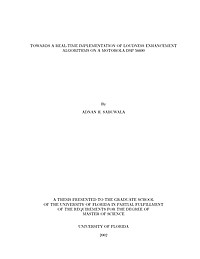
Towards a Real-Time Implementation of Loudness Enhancement Algorithms on a Motorola DSP 56600
Most of the cellular phone companies with audio speaker capabilities focus on reducing the current drain to extend battery life. None of these companies concentrate on modifying the speech signal itself to make it sound louder in noisy listener environments without adding additional energy. Such algorithms have been described in literature by Boillot and form the backbone of this thesis. The current project focusses on taking a step towards running these algorithms in real-time on a 16-bit fixed point Motorola DSP 56600. Implementation of the autocorrelation, Levinson- Durbin, FIR, and IIR filters in assembly for the Motorola DSP 56600 has been investigated in the thesis. The challenges and alternate solutions to circumvent the challenges have been described, and experimental results have been presented. Results indicate that the modified signed LMS algorithm, which can be considered to be a blend between the LMS and signed LMS algorithms, turns out to be an elegant solution to circumvent the challenges in implementing the Levinson-Durbin recursion.








